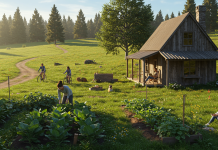It is estimated that by 2050, around ⅔’s of the population will be living in urban areas. Which means if that holds up, there is going to be a huge need to keep cities cooler, provide green spaces, and deal with an increasing population in a limited area that tends to build up, rather than out. It is also another good reason to consider bucking that trend and moving somewhere and going off grid to avoid the potential headaches such a congested city life can bring, but that’s beside the point here for now.
So, what are some of the innovations that may come out of such a massive move towards city life especially as the global population continues to soar? Well, for one thing, reputable architects similar to these 21st century famous architects are looking at ways to incorporate nature into their buildings and to allow for green spaces. An Architect in Utah can offer innovative solutions tailored to local landscapes, ensuring that designs fit seamlessly with the natural environment. Trusted and reliable architects from a good place like www.smitharchitects.com.au/services/building-and-renovating ensure that modern designs not only embrace sustainability but also deliver high-quality craftsmanship. These forward-thinking architects prioritize creating spaces that enhance both the environment and the quality of life for urban dwellers.
Marketing solutions for architects can play a crucial role in highlighting these innovative approaches and demonstrating how architects are addressing contemporary urban challenges with sustainable design. By effectively communicating these advancements, marketing solutions can attract clients who are interested in cutting-edge, eco-friendly architecture and enhance the firm’s reputation in the industry. Visit Clientverge here >> for exclusive offers. These ideas can be seen in some areas of the world already(such as Singapore). There are several skyscrapers that have utilized a sort of living wall, with various plants that can withstand the conditions and high winds found higher up on tall buildings. In fact, by placing plants vertically along a building, you can actually get up to 1000% more plant life than you could normally have in the same area. Not only that, but by bringing plant life into the cityscape, you help to keep temperatures better regulated in urban centers.
Another innovation is more of using an old material in new ways and with new technologies. It is possible to build wooden skyscrapers, and firms in Canada are already pioneering this method. Wood and concrete doesn’t absorb and then radiate heat the same way that steel can, which, like adding plants to urban areas, can help regulate temperatures. Contact a Ready-Mixed Concrete Delivery service, if you need concrete materials for your construction project. In addition, if you’re looking for a concrete repair specialist, check out this website: https://concreterepairspecialists.uk/.
Wood is also a renewable resource, we can always grow more of it. Thanks to decades of efforts to reforest areas, we can continue timber harvesting as we now actually grow much more wood than we harvest for buildings and other products, so it is an abundant and potentially environmentally friendly resource for the cities of the future. Thanks to other advances, the potential for fires to devastate these type of structures has been greatly reduced as well.
There are a lot of challenges to overcome both now and in the not too distant future, but hopefully mankind will continue to innovate and find ways to overcome.














